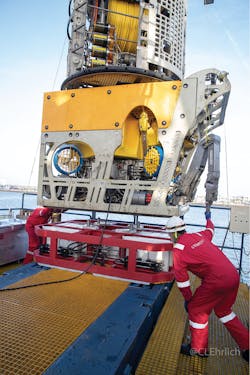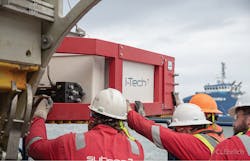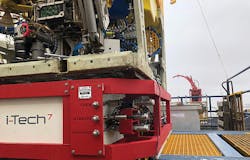Hydrate remediation skid acts quickly to prevent production blockages
Gram Hall, i-Tech 7
A newly developed hydrate remediation skid (HRS) incorporates smart, real-time software to address and prevent the potentially harmful build-up of hydrate in small volume subsea pipeline systems. Subsea 7’s Life of Field business unit i-Tech 7 constructed the equipment last year at a site on the coast of the US Gulf of Mexico. It is designed for operations in water depths of up to 3,000 m (9,842 ft).
The HRS, which weighs 726 kg (1,600 lb) in the air and is neutrally buoyant in seawater, is designed to interface with work class and heavy work-class ROVs, operating from multi-service vessels or drilling rigs. It can be integrated with any ROV in the market, regardless of whether it is a top hat or cage system, as part of i-Tech 7’s hydrate remediation service. The company provides a combination of pressure reduction and chemical injection technology to dislodge and disassociate blockages in subsea production facilities.
Instrumentation and controls on the skid allow blockage issues to be accurately identified and addressed, restoring production as quickly as possible to the customer’s facility in the event of an unplanned shutdown.
Although the HRS’ flow rate performance (configured with redundant pumps) is typical of conventional ROV-mounted pumps (2 g/m/7.5 l/m), it can operate at pressures of up to 6,000 psi (415 bar). At maximum operating depth, hydrostatic pressure is around 4,500 psi (310 bar), but the system can reduce this pressure down to 15 to 30 psi (1 to 2 bar). Its automated controls can de-pressurize jumpers, wellheads, umbilicals, and chemical injection lines with small volume production piping infrastructure. Unlike conventional skids, the power supply is built into the unit. This allows distribution of power across to the skid to be completely isolated from the ROV’s power.
Ancillary equipment
An ancillary piece of equipment, but complementary to the hydrate skid, is the subsea reservoir skid, a 2.6 x 6-m (8.5 x 20-ft) frame that holds 4 x 400-gallon bladders. This allows the operator to take the skid subsea with ‘clean’ fluids for injecting while the system simultaneously returns ‘dirty’ fluids. The HRS can dispose of the effluent into a sealed container for recovery of both small and large amounts of hydrocarbons. The subsea reservoir system is fully configurable and is deployed by crane and positioned on the seabed near the access point to the subsea asset. Once on the seabed, the ROV will retrieve one end of a hydraulic flying lead that is inserted into the hot stab manifold on the subsea reservoir system. It then takes the other side of the flying lead and plugs it into the manifold (mounted on the ROV) that connects to the effluent line on the hydrate skid. The skid is then turned on, with fluid from the reservoir drawn through the skid into the affected line.
An external rental tool can be added to allow a rapid fly-by external inspection of the pipeline using a non-intrusive sensor. This helps to assess wall thickness and provide early identification, in real time, of hydrate and wax anomalies. Pressurized hydrate inhibitors are then routed through the production piping in either direction to inhibit the flowline and prevent hydrate reformation.
Features and safeguards
The HRS is designed to operate with as close to 100% uptime as possible. If maintenance is required, components can be easily and quickly interchanged, with only one electrical line and two hydraulic lines needed to connect to the ROV. Communications are processed through the ROV umbilical and into the control room where the hydrate remediation technician operates the software from a laptop while liaising directly with the ROV pilot and co-pilot.
Various built-in safety features are designed to mitigate risk:
• If communications are lost during operations all valves will auto-function to the closed position
• Should all power be lost to the skid and pressure to the line is higher than ambient, the check valves, which are built into the pumps, will not allow the inventory of the line to escape through the system
• Software has built-in failsafe measures to minimize human error during operations.
Circuit monitoring
The HRS employs new digital technology that channels electrically actuated process valving for the management, monitoring, and distribution of hydraulic process circuits. Automated control affords the user greater flexibility in monitoring the interaction and behavior of the hydrocarbon contents of the operator’s pipeline. With comprehensive topsides software control, the operator is in a better position to accurately monitor pressure and flows.
Onboard instruments provide high fidelity measurements of pressure versus volume recordings to assist identification of the approximate location of blockages. To precisely disassociate hydrates from the natural gas, the skid can also accurately mix and inject the inhibiting (anti-freeze) chemicals into the process line to treat de-inventoried production hydrocarbons, thereby preventing hydrates re-forming during recovery. The instrumentation can then precisely measure developments and exploit these to monitor the hydrate removal rate. Improved diagnostics will allow more efficient and accurate decision making, helping the company to deploy well stimulation solutions earlier and more effectively.To qualify the new hardware, the HRS recently underwent two sea trials in water depths of 1,493 m (4,900 ft) in an offshore environment. The skid was fitted to an ROV and was configured to perform tests while ROV operations were off the critical path. The company worked with flow assurance engineers to gain access to the affected line blockage to ensure the best means of access and with the operator to inject chemicals for treating the production stream and mitigating the formation of blockages.
During its initial deployment the skid performed without any technical difficulties, with function testing of all systems conducted in deepwater conditions. Any adjustments to system parameters were performed with onshore support in real time. The trial was successfully concluded with 100% of the hydrate removed and remediated.
The HRS can be used to inject, through a metering valve, very precise amounts of dosing chemicals into the subsea asset without the need for any further reconfiguration to the system. It is also suited to tasks such as ROV workover control, hydro-testing, back seal testing, and other fluid injection activities. •


